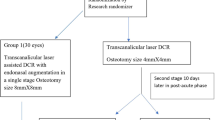Abstract
Chronic dacryocystitis is a frequently encountered condition which can be corrected by dacryocystorhinostomy. Today, the diode laser is increasingly put to use in such corrective operations. This study aims to answer the questions of which adjunctive procedures and which combinations of such procedures are necessary and effective in securing more successful outcomes in diode laser dacryocystorhinostomy. This prospective randomized study included eighty patients (13 male, 67 female) who underwent dacryocystorhinostomy in our hospital during the 2 year period of January 2009–January 2011. The patients were selected consecutively and were randomly allocated to three groups. Group 1 (30): diode laser + mitomycin C + silicone intubation; Group 2 (27): diode laser + silicone intubation; Group 3 (23): diode laser + mitomycin C. All patients were evaluated postoperatively on day 1, week 1, and on the 1st, 3rd, 6th, 12th, 18th, and 24th months. The postoperative evaluation consisted of preoperative and postoperative ostium measurements, recording postoperative complications, and calculating and comparing success rates and operative times. The mean ages of the patients were 63.4 for Group 1, 60.7 for Group 2, and 61.8 for Group 3. No statistically significant difference was found among the groups regarding pre- and postoperative ostium measurements. The success rates were 84.3, 80, and 76.9 % for Groups 1, 2, and 3, respectively. Complications noted in Group 1 were restenosis (3), premature silicone tube loss (1), development of granulation tissue (3), synechia (2), infection (2), and hemorrhage (3). Those for Group 2 were restenosis (5), premature tube loss (2), granulation (8), synechia (6), infection (3), and hemorrhage (4). Group 3 had 6 cases with stenosis, 5 with granulation, 3 with infection, 6 with synechia, and 5 with hemorrhage. The operative times of the groups were 25.5, 15.3, and 18.1 min, respectively, for Group 1, 2, and 3. All three groups had statistically significant differences regarding the duration of surgery, with p < 0.001, p < 0.001, and p = 0.002 for Group 1 and 2, Group 1 and 3, and Group 2 and 3, respectively. Our study showed that when diode laser DCR was combined with bicanalicular silicone intubation and intraoperative mitomycin C application, those adjunctive procedures, while increasing operative time, enhanced the success rate and diminished complications as compared to diode laser plus intubation and/or diode laser plus mitomycin C.


Similar content being viewed by others
References
Drnovsek-Olup B, Beltram M (2010) Transcanalicular diode laser-assisted dacryocystorhinostomy. Indian J Ophthalmol 58:213–217
Wakaki S, Marumo H, Tomioka K et al (1958) Isolation of new fractions of antitumor mitomycins. Antibiot Chemother 8:228–240
Ugurbas SH, Zilelioglu G, Sargon M et al (1997) Histopathologic effects of mitomycin-C on endoscopic transnasal dacryocystorhinostomy. Ophthalmic Surg Lasers 28:300–304
Hu D, Sires BS, Tong DC et al (2000) Effect of brief exposure to mitomycin C on cultured nasal mucosa fibroblasts. Ophthal Plast Reconstr Surg 16:119–125
Malhotra R, Wright M, Olver JM (2003) A consideration of the time taken to do dacryo-cystorhinostomy (DCR) surgery. Eye 17:691–696
Metson R, Woog JJ, Puliafito CA (1994) Endoscopic laser dacryocystorhinostomy. Laryngoscope 104:269–274
Henson RD, Henson RG Jr, Cruz HL Jr, Camara JG (2007) Use of the diode laser with intraoperative mitomycin C in endocanalicular laser dacryocystorhinostomy. Ophthal Plast Reconstr Surg 23:134–137
Camara JG, Bengzon AU, Henson RD (2000) The safety and efficacy of mitomycin C in endonasal endoscopic laser-assisted dacryocystorhinostomy. Ophthal Plast Reconstr Surg 16:114–118
Selig YK, Biesman BS, Rebeiz EE (2000) Topical application of mitomycin C in endoscopic dacryocystorhinostomy. Am J Rhinol 14:205–207
You YA, Fang CT (2001) Intraoperative mitomycin C in dacryocystorhinostomy. Ophthal Plast Reconstr Surg 17:115–119
Liao SL, Kao SC, Tseng JH et al (2000) Results of intraoperative mitomycin C application in dacryocystorhinostomy. Br J Ophthalmol 84:903–906
Prasannaraj T, Kumar BY, Narasimhan I, Shivaprakash KV (2012) Significance of adjunctive mitomycin C in endoscopic dacryocystorhinostomy. Am J Otolaryngol 33:47–50
Maeso Riera J, Sellarès Fabrés MT (2007) Trans-canalicular diode laser dacryocystorhinostomy: technical variations and results. Acta Otorrinolaringol Esp 58:10–15
Piédrola Maroto D, Franco Sánchez J, Reyes Eldblom R, Monje Vega E, Conde Jiménez M, Ortiz Rueda M (2008) Endonasal versus trans-canalicular endoscopic dacriocystorhinostomy using diode laser. Surgical techniques and outcomes. Acta Otorrinolaringol Esp 59:283–287
Alañón Fernandez MA, Alañón Fernandez FJ, Martínez Fernández A, Cárdenas Lara M (2006) Results the application of mitomicyn during endonasal and endocanalicular dacryocystorhinostomy by diode laser. Acta Otorrinolaringol Esp 57:355–358
Unlu HH, Toprak B, Aslan A et al (2002) Comparison of surgical outcomes in primary endoscopic dacryocystorhinostomy with and without silicone intubation. Ann Otol Rhinol Laryngol 111:704–709
Anderson RL, Edwards JJ (1979) Indications, complications and results with silicone stents. Ophthalmology 86:1474–1487
Feng YF, Cai JQ, Zhang JY, Han XH (2011) A meta-analysis of primary dacryocystorhinostomy with and without silicone intubation. Can J Ophthalmol 46:521–527
Piaton JM, Keller P, Limon S, Quenot S (2002) First line endonasal dacryocystorhinostomy technique and results. Comparison between diode laser and electrocautery instrument. Study based on 422 procedures. J Fr Ophtalmol 25:135–145
Sarafoleanu C, Manea CM (2010) Modified endoscopic DCR without stenting and laser assisted. Oftalmologia 54:88–94
Linberg JV, Anderson RL, Bumsted RM, Barreras R (1982) Study of intranasal ostium external dacryocystorhinostomy. Arch Ophthalmol 100:1758–1762
Olver J (2002) Colour atlas of lacrimal surgery. Butterworth-Heinemann, Oxford, pp 98–99
Linberg JV, Anderson RL, Bumsted RM, Barreras R (1982) Study of intranasal ostium external dacryocystorhinostomy. Arch Ophthalmol 100:1758–1762
Ezra E, Restori M, Mannor GE, Rose GE (1998) Ultrasonic assessment of rhinostomy size following external dacryocystorhinostomy. Br J Ophthalmol 82:786–789
Kong YT, Kim TI, Kong BW (1994) A report of 131 cases of endoscopic laser lacrimal surgery. Ophthalmology 101:1793–1800
Woog JJ, Metson R, Puliafito CA (1993) Holmium:YAG endonasal laser dacryocystorhinostomy. Am J Ophthalmol 116:1–10
Author information
Authors and Affiliations
Corresponding author
Rights and permissions
About this article
Cite this article
Dogan, R., Meric, A., Ozsütcü, M. et al. Diode laser-assisted endoscopic dacryocystorhinostomy: a comparison of three different combinations of adjunctive procedures. Eur Arch Otorhinolaryngol 270, 2255–2261 (2013). https://doi.org/10.1007/s00405-013-2351-1
Received:
Accepted:
Published:
Issue Date:
DOI: https://doi.org/10.1007/s00405-013-2351-1




